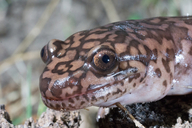|
Description
A large, heavy, terrestrial salamander. Gilled adults are found in some populations. Transformed adults reach sizes of 17 - 30.5 cm total length and larval adults may reach 35 cm (Stebbins 1985; Petranka 1998).
In transformed adults, the dorsal color is reddish brown overlain with copper-colored, coarse marbling. The marbling often extends to the chin, throat and undersides of the forelimbs (Nussbaum 1976).
Young metamorphs have bright, golden marbling (Petranka 1998).
Distribution and Habitat
Country distribution from AmphibiaWeb's database: United States U.S. state distribution from AmphibiaWeb's database: California
Restricted to Coast Ranges in California, from Sonoma and Napa counties south to Santa Cruz county with a geographic isolate in Monterey county (Stebbins 1985; Petranka 1998).
Giant salamanders inhabit humid, forested areas, and are found in and around permanent and semi-permanent streams. Larvae are more abundant than adults and tend to occur in small to medium sized mountain streams. Adults are rare, but occasionally can be found under rocks and logs near, or under rocks in streams during the breeding season (Petranka 1998).
Life History, Abundance, Activity, and Special Behaviors
Little is known about the biology of the terrestrial adult. Information on mating and courtship is not available. Nests of D. ensatus have been found below cover objects (rocks and longs) submerged in running water. Clutch size ranged from 70 - 100 eggs (Petranka 1998).
Dicamptodon ensatus are probably similar to other species of Dicamptodon in many features. Larval diet has not been studied, but presumably includes aquatic invertebrates and some aquatic vertebrates, as seen in D. copei (Nussbaum et al. 1983).
Juveniles and adults forage above ground on rainy nights and can sometimes be found on rural roads. Adult D. ensatus have been reported to eat smaller D. ensatus. Birds and shrews may also prey on D. ensatus, but they have to contend with a strong defensive bite (Petranka 1998).
Dicamptodon ensatus are known to vocalize (Stebbins 1951), sometimes described as a barking, buzzing sound usually in a defensive behaviour. See the media files linked above.
Larva
Larvae are the stream type and have short, bushy gills and a low tail fin that extends forward to the hindlimb insertion. Larval coloration is light brown above with a white to yellowish venter. The tail lacks the conspicuous blotching seen in larval D. tenebrosus. A yellow stripe is usually present behind the eyes and the tips of the digits are black and cornified (Petranka 1998).
Larvae reach high densities in cool running streams, and are likely an important component of stream communities (Petranka 1998). Trends and Threats
This species has a small range and is threatened by logging and development. Stream siltation is a particular problem for the larvae (Petranka 1998). Comments
On the basis of genetic differentiation, D. tenebrosus was recognized as a species distinct from D. ensatus (Good 1989). The genus Dicamptodon was historically included as a subfamily (Dicamptodontinae) in the family Ambystomatidae, and was placed in a separate family, Dicamptodontidae, based on features of the spinal nerves (Edwards 1976).
An intraspecies examination found four geographically based mtDNA groups and three nuclear DNA groupings (Lavin et al. 2021). These three nuclear groups may correspond to three geographically separate areas of the range as historical records show an absence from the Petaluma Gap region (Thomson et al. 2016).
See another account at californiaherps.com.
References
Edwards, J.L. (1976). "Spinal nerves and their bearing on salamander phylogeny." Journal of Morphology, 148, 305-328.
Good, D.A. (1989). "Hybridization and cryptic species in Dicamptodon (Caudata: Dicamptodontidae)." Evolution, 43, 728-744.
Lavin BR, Callahan BS, Connell RA, and Girman DJ (2021). "Phylogeography and Genetic Structure in the California Giant Salamander (Dicamptodon ensatus): Impacts of current and historic landscape features." Zootaxa, 5068(1), 60-80. [link]
Nussbaum, R. A. (1976). "Geographic variation and systematics of salamanders of the genus Dicamptodon Strauch (Ambystomatidae)." Miscellaneous Publications of the Museum of Zoology, University of Michigan, 149, 1-94.
Nussbaum, R. A., Brodie, E. D., Jr., and Storm, R. M. (1983). Amphibians and Reptiles of the Pacific Northwest. University of Idaho Press, Moscow, Idaho.
Petranka, J. W. (1998). Salamanders of the United States and Canada. Smithsonian Institution Press, Washington D.C. and London.
Stebbins, R. C. (1985). A Field Guide to Western Reptiles and Amphibians. Houghton Mifflin, Boston.
Stebbins, R.C. (1951). Amphibians of Western North America. University of California Press, Berkeley.
Thomson, R.C., Wright, A.N., Shaffer, H.B., Bolster, B., Cripe, K., Barry, S.J., Fisher, R. N., and Welsh, H.H. (2016). California Amphibian and Reptile Species of Special Concern (1st ed.). University of California Press, Oakland, California. [link]
Originally submitted by: Meredith J. Mahoney (first posted 2000-03-06)
Edited by: Meredith J. Mahoney, Michelle S. Koo (2022-08-18)Species Account Citation: AmphibiaWeb 2022 Dicamptodon ensatus: California Giant Salamander <https://amphibiaweb.org/species/3866> University of California, Berkeley, CA, USA. Accessed Feb 21, 2025.
Feedback or comments about this page.
Citation: AmphibiaWeb. 2025. <https://amphibiaweb.org> University of California, Berkeley, CA, USA. Accessed 21 Feb 2025.
AmphibiaWeb's policy on data use.
| 